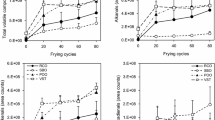Abstract
The effect of various conditions (storage temperature, exposure to light, access of oxygen) and different packaging material (amber glass, amber polyethylene terephthalate) on the nutritional value of cold-pressed rapeseed oil during 12 months of storage was investigated. Quantified quality parameters included: acidity, peroxide value, spectrophotometric indices (K 232 , K 268 ), fatty acid composition, tocopherols and sterols. Storage of oil at 4 °C was found to be most appropriate for maintaining the quality of cold-pressed rapeseed oil. Exposure of oil samples stored at room temperature to light in combination with the access of oxygen caused the most pronounced losses in the total tocopherols (ca. 90–91 % of α-T, and ca. 80–81 % of γ-T), total phytosterols (ca. 15–16 %) and substantial deterioration in oil qualitative properties. Although storage at room temperature is common for use in households, storage of at low temperatures (4 °C) significantly increases the possibility of prolonged shelf life of cold-pressed rapeseed oil.



Similar content being viewed by others
Abbreviations
- HCA:
-
Hierarchical cluster analysis
- PCA:
-
Principal component analysis
- PET:
-
Polyethylene terephthalate
- PV:
-
Peroxide value
- RT:
-
Room temperature
- α-T:
-
Alpha tocopherol
- γ-T:
-
Gamma tocopherol
References
Ayton J, Mailer RJ, Graham K (2012) The effect of storage conditions on extra virgin olive oil quality (accessed Apr. 2012). RIRDC Publication No. 12/024. RIRDC Project No. PRJ-002297. https://rirdc.infoservices.com.au
Cecchi T, Passamonti P, Cecchi P (2010) Study of the quality of extra virgin olive oil stored in PET bottles with or without an oxygen scavenger. Food Chem 120:730–735
Choe E, Min D (2006) Mechanisms and factors for edible oil oxidation. Compr Rev Food Sci Food Saf 5:169–186
Choe E, Min D (2009) Mechanisms of antioxidants in the oxidation of oils. Compr Rev Food Sci Food Saf 8:345–358
Dubois V, Breton S, Linder M, Fanni J, Parmentier M (2007) Fatty acid profiles of 80 vegetable oils with regard to their nutritional potential. Eur J Lipid Sci Tech 109:710–732
Fadda C, Del Caro A, Sanguinetti AM, Urgeghe PP, Vacca V, Arca PP, Piga A (2012) Changes during storage of quality parameters and in vitro antioxidant activity of extra virgin monovarietal oils obtained with two extraction technologies. Food Chem 134:1542–1548
Guillaume C, Ravetti L (2012) Evaluation of new analytical methods to detect lower quality olive oils (accessed Jun. 2012). RIRDC Publication No. 12/007, RIRDC Project No. PRJ-003349. https://rirdc.infoservices.com.au/items/12-007
ISO (1996) Animal and vegetable fats and oils. Determination of peroxide value. International Organization for Standardization, Geneva (ISO 3960)
ISO (2000) Animal and vegetable fats and oils. Preparation of methyl esters of fatty acids. International Organization for Standardization, Geneva (ISO 5509)
ISO (2005) Animal and vegetable fats and oils. Determination of acid value and acidity. International Organization for Standardization, Geneva (ISO 660)
ISO (2011) Animal and vegetable fats and oils. Determination of ultraviolet absorbance expressed as specific UV extinction. International Organization for Standardization, Geneva (ISO 3656)
List GR, Wang T, Shukla VKS (2005) Storage, handling and transport of oils. In: Shahidi F (ed) Bailey’s industrial oil and fat products and fats. Wiley, New Jersey, pp. 191–229
Méndez AI, Falqué E (2007) Effect of storage time and container type on the quality of extra virgin olive oil. Food Control 18:521–529
Mezouari S, Eichner K (2007) Comparative study on the stability of crude and refined rice bran oil during long-term storage at room temperature. Eur J Lipid Sci Tech 109:198–205
Morello JR, Motilva MJ, Tovar MJ, Romero MP (2004) Changes in commercial virgin olive oil (cv. Arbequina) during storage, with special emphasis on the phenolic fraction. Food Chem 85:357–364
Niewiadomski H (1990) Preliminary technological operations. In: Niewiadomski H (ed) Rapeseed – chemistry and technology. Elsevier, Amsterdam, pp. 123–160
Obiedzińska A, Waszkiewicz-Robak B (2012) Cold pressed oils as functional food. Food Sci Tech Quality 80:27–44
Okogeri O, Tasioula-Margari M (2002) Changes occurring in phenolic compounds and alpha-tocopherol of virgin olive oil during storage. J Agric Food Chem 50:1077–1080
Pekkarinen S, Hopia A, Heinonen M (1998) Effect of processing on the oxidative stability of low erucic acid turnip rapeseed (Brassica rapa) oil. Fett-Lipid 3:69–74
Pristouri G, Badeka A, Kontominas MG (2010) Effect of packaging material headspace, oxygen and light transmission, temperature and storage time on quality characteristics of extra virgin olive oil. Food Control 21:412–418
Przybylski R, Eskin NAM (2006) Minor components and the stability of vegetable oils. Inform 17:187–189
Robertson GL (2012) Vegetable oils. In: Robertson GL (ed) Food packaging: principles and practice. CRC Press, New York, pp. 503–505
Sacchi R, Savarese M, Del Regno A, Paduano A, Terminiello P, Ambrosino ML (2008) Shelf life of vegetables oils bottled in different scavenging polyethylene terephthalate (PET) containers. Packag Technol Sci 21:269–277
Samaniego-Sanchez C, Oliveras-Lopez MJ, Quesada-Granados JJ, Villalon-Mir M, Lopez-G Serrana H (2012) Alterations in picual extra virgin olive oils under different storage conditions. Eur J Lipid Sci Technol 114:194–204
Acknowledgments
The present study was financed by the National Science Centre in Poland (project no. N N312 256740).
Author information
Authors and Affiliations
Corresponding author
Ethics declarations
Conflict of interest
The authors have declared no conflict of interest.
Additional information
Research highlights
• Both amber glass and PET bottles ensured comparable preservation of rapeseed oil quality.
• Rapeseed oil samples kept at 4 °C maintained its original profile over 12 months of storage.
• Similar loss in oil quality occurred during samples storage under light and in the dark.
• Access of oxygen cause the most pronounced losses in minor components.
Rights and permissions
About this article
Cite this article
Wroniak, M., Rękas, A. Nutritional value of cold-pressed rapeseed oil during long term storage as influenced by the type of packaging material, exposure to light & oxygen and storage temperature. J Food Sci Technol 53, 1338–1347 (2016). https://doi.org/10.1007/s13197-015-2082-y
Revised:
Accepted:
Published:
Issue Date:
DOI: https://doi.org/10.1007/s13197-015-2082-y




